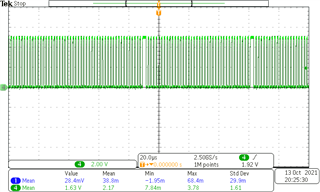Hello,
I am having issues with the duty cycle generated in my code. I am using this code in my power converter but in this case, I am just giving a fixed duty cycle value and only turning on the gate driver supply (not running the converter). However, I am getting random variations in the duty cycle, even though it is fixed, which I believe is why I am having spikes when running the converter in closed loop. I have inserted below a snippet of my main code and the functions I am using to set period and duty cycle.
I am eliminating sub-sections of the code and trying to figure out where the problem is. What didn't make sense to me is that the code runs fine when I am just setting duty cycle values and calling the function, but adding the line of code " Vbuck_new=3;" gives me the random switching.
while (1){
/*
P1OUT = 0b0;
adc_chan=7;
ADC10MCTL0 = (ADC10MCTL0 & ~ADC10INCH_1) | ADC10INCH_7;
GetADC(); // Vin_temp
Vin_3=Vin_2;
Vin_2=Vin_1;
Vin_1=Vin_0;
Vin_0=Vin_temp;
Vin=(Vin_0+Vin_1+Vin_2+Vin_3)>>2;
__delay_cycles(10);
__no_operation();
Vin_new=Vin/52;
*/
Vbuck_new=3; //Vbuck_temp/57;
D_buckH=85;//333*(Vbuck_new/Vin_new);
if (D_buckH>280){
D_buckH=280;
}
else if (D_buckH<75){
D_buckH=75;
}
D_buckL=D_buckH+1;
__delay_cycles(10); // Delay between sequence convs
SetDuty_Buck (D_buckH, D_buckL);
__no_operation();
}
void SetPWM(unsigned int tbuck, unsigned int tboost){
// Configure TimerD in Hi-Res Regulated Mode - for TD0
TD0CTL0 = TDSSEL_2; // TDCLK=SMCLK=25MHz=Hi-Res input clk select
TD0CTL1 |= TDCLKM_1; // Select Hi-res local clock
TD0HCTL1 |= TDHCLKCR; // High-res clock input >15MHz
TD0HCTL0 = TDHM_0 + // Hi-res clock 8x TDCLK = 200MHz
TDHREGEN + // Regulated mode, locked to input clock
TDHEN; // Hi-res enable
// Configure TimerD in Hi-Res Regulated Mode - for TD1
TD1CTL0 = TDSSEL_2; // TDCLK=SMCLK=25MHz=Hi-Res input clk select
TD1CTL1 |= TDCLKM_1; // Select Hi-res local clock
TD1HCTL1 |= TDHCLKCR; // High-res clock input >15MHz
TD1HCTL0 = TDHM_0 + // Hi-res clock 8x TDCLK = 200MHz
TDHREGEN + // Regulated mode, locked to input clock
TDHEN; // Hi-res enable
while(!TDHLKIFG); // Wait until hi-res clock is locked - frequency lock Interrupt Flag
TD0CTL0 |= TDCLR; // Reset timer for TD1
TD0CCR0 = tbuck; // Period Register - 200MHz/(100kHz)= 2000 - using high resolution clock
TD1CTL0 |= TDCLR; // reset timer for TD1
TD1CCR0 = tboost; // Period Register - 200MHz/(100kHz)= 2000 - using high resolution clock
}
void SetDuty_Buck (unsigned int dbuckH, unsigned int dbuckL) {
TD0CTL0 |= TDCLR; // reset timer for TD1
TD0CCTL1 |= OUTMOD_2 + CLLD_2; // CCR1 toggle/reset
TD0CCR1 = dbuckH; // CCR1 PWM duty cycle of 1000/2000 = 50%
TD0CCTL2 |= OUTMOD_6 + CLLD_2; // CCR2 toggle/set
TD0CCR2 = dbuckL; // CCR2 PWM duty cycle of 500/2000 = 25%
TD0CTL0 |= MC_3 + TDCLR; // up/down-mode, clear TDR, Start timer
}
The first two figures below show the switching waveforms and the last one is the voltage transient that happens because of this random switching.



Thank you.

